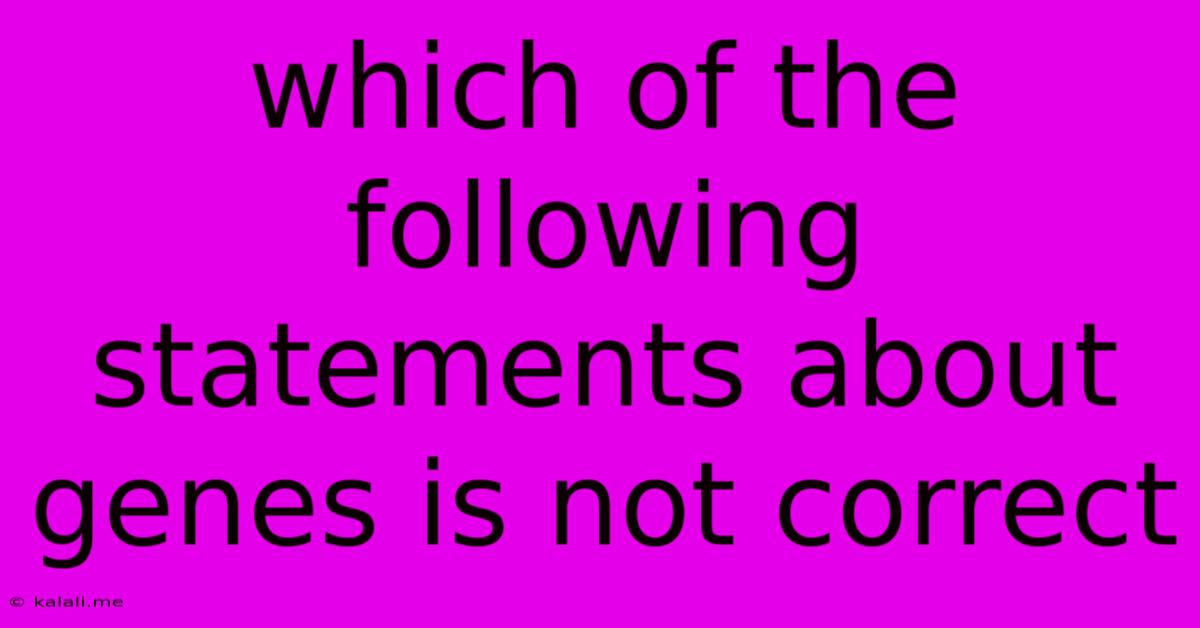Which Of The Following Statements About Genes Is Not Correct
Kalali
Jun 13, 2025 · 3 min read

Table of Contents
Which of the Following Statements About Genes is Not Correct? A Deep Dive into Genetics
This article explores common misconceptions surrounding genes. Understanding the intricacies of genetics is crucial, whether you're a student, a researcher, or simply curious about the building blocks of life. We'll examine several statements about genes and pinpoint the inaccurate one, clarifying the correct understanding of genetic principles. This will also cover key concepts like gene expression, mutations, and the role of genes in inheritance.
Understanding Genes: The Fundamental Units of Heredity
Before we delve into the incorrect statement, let's establish a basic understanding. Genes are segments of DNA that contain the instructions for building specific proteins. These proteins carry out a vast array of functions in the body, influencing everything from our physical traits (like eye color and height) to our susceptibility to certain diseases. The complete set of genes within an organism is known as its genome. Genes are organized into chromosomes, thread-like structures found within the nucleus of our cells.
Analyzing the Statements:
Let's consider some common statements about genes and identify the inaccurate claim. Remember, the context of a statement can influence its validity, so the following examples represent statements often encountered in introductory genetics studies.
Statement A: Genes are composed of DNA.
This statement is correct. DNA (deoxyribonucleic acid) is the fundamental molecule that makes up genes. The sequence of nucleotides (adenine, guanine, cytosine, and thymine) within a gene dictates the amino acid sequence of the protein it encodes.
Statement B: Genes determine all aspects of an organism's phenotype.**
This statement is incorrect. While genes play a crucial role in determining an organism's traits (phenotype), they are not the sole determinant. Environmental factors also significantly impact an organism's phenotype. For example, nutrition affects height, and sun exposure influences skin pigmentation. Gene-environment interactions are complex and shape the final outcome. Epigenetics also plays a role, influencing gene expression without altering the underlying DNA sequence.
Statement C: Genes are passed from parents to offspring during reproduction.**
This statement is correct. This is the fundamental principle of inheritance. Genes are transmitted from one generation to the next through the process of sexual reproduction, with each parent contributing half of their genetic material to their offspring.
Statement D: All genes are expressed at all times in all cells.**
This statement is incorrect. Gene expression is a highly regulated process. Not all genes are active in every cell at all times. A skin cell, for example, expresses different genes compared to a neuron in the brain. The specific genes expressed in a cell determine its specialized function and characteristics. This is a critical concept in developmental biology and cell differentiation. Environmental signals and internal cellular mechanisms tightly control when and where specific genes are switched "on" or "off".
Conclusion:
Therefore, the statements that are not correct are B and D. Genes are a vital component of heredity and influence many aspects of an organism, but environmental factors and the highly regulated nature of gene expression greatly impact the ultimate phenotype and cell function. Understanding the complexities of gene function, regulation, and interaction with the environment is critical for a comprehensive understanding of biology.
Latest Posts
Latest Posts
-
Who Is The Father Of Computer Security
Jun 14, 2025
-
What Is Not Part Of The Axial Skeleton
Jun 14, 2025
-
What Is The Measure Of Abc 88
Jun 14, 2025
-
Which Network Device Connects Multiple Networks Together
Jun 14, 2025
-
Which Of The Following Is The Best
Jun 14, 2025
Related Post
Thank you for visiting our website which covers about Which Of The Following Statements About Genes Is Not Correct . We hope the information provided has been useful to you. Feel free to contact us if you have any questions or need further assistance. See you next time and don't miss to bookmark.